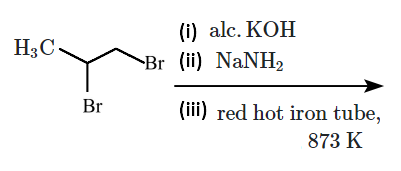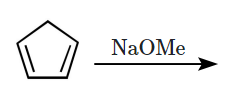Select Chapter Topics:
Among the following, the compound which contains the fewest tertiary carbons is:
1.
\((CH_3)_3C(CH_2)_2CH_3~~~~~~~~~~~~~\)
2.
4-isobutyl heptane
3.

4.



Subtopic: Aliphatic Hydrocarbon- Physical Properties |
From NCERT
Please attempt this question first.
Hints
Please attempt this question first.
Find out the correct statement:
1. Only B is correct.
2. A and C.
3. B and C.
4. Only A is correct.
| A. | The number of possible theoretical conformations of ethane is 6. |
| B. | In the conformations of ethane, the staggered form has the least torsional strain, and the eclipsed form has the maximum torsional strain. |
| C. | Hückel Rule: The presence of (4n + 2) π electrons in the ring where n is an integer (n = 1, 2, ......). |
2. A and C.
3. B and C.
4. Only A is correct.
Subtopic: Aliphatic Hydrocarbon- Physical Properties | Aromatic Hydrocarbons - Nomenclature, Isomerism & Huckel's Rule |
From NCERT
Please attempt this question first.
Hints
Please attempt this question first.
Why does the addition of \(\text{HI}\) in the presence of a peroxide catalyst not follow anti-Markovnikov's rule?
| 1. | \(HI\) is a strong reducing agent. |
| 2. | The \(\text{H–I}\) bond is too strong to be broken homolytically. |
| 3. | The \(I\) atom combines with \(H\) atom to give back \(HI.\) |
| 4. | The iodine atom is not reactive enough to add across a double bond. |
Subtopic: Aliphatic Hydrocarbon - Methods of Preparation |
From NCERT
Please attempt this question first.
Hints
Please attempt this question first.
Cyclohexene on ozonolysis by reaction with zinc dust and water gives compound E. Compound E on further treatment with aqueous \(KOH\) yields compound F. Compound F is:
| 1. |  |
2. |  |
| 3. |  |
4. |  |
Subtopic: Aliphatic Hydrocarbon - Methods of Preparation |
From NCERT
Please attempt this question first.
Hints
Please attempt this question first.
Subtopic: Aromatic Hydrocarbons - Nomenclature, Isomerism & Huckel's Rule |
58%
From NCERT
Please attempt this question first.
Hints
Please attempt this question first.
Consider the following statements:
The correct statements is/are:
| a. | Benzene hexachloride is an aromatic compound. |
| b. | \(-NHCOCH_3\) is meta directing group towards aromatic electrophilic substitution reaction. |
| c. | In an arenium ion, one of the carbon is sp3 hybridised. |
| 1. | (a) and (b) only | 2. | (a) and (c) only |
| 3. | (c) only | 4. | (a), (b) and (c) |
Subtopic: Aromatic Hydrocarbons - Benzene - Structure, Preparation & Chemical Reactions |
From NCERT
Please attempt this question first.
Hints
Please attempt this question first.
Consider the given two statements:
| Statement I: | Addition of \(\text{Cl}_2\) in the presence of \(\text{CCl}_4 \) with alkene will give geminal dichloride. |
| Statement II: | The addition of two moles of HCl with alkyne will give vicinal dichloride. |
| 1. | Statement I is True and Statement II is False. |
| 2. | Statement I is False and Statement II is True. |
| 3. | Both Statement I and Statement II are True. |
| 4. | Both Statement I and Statement II are False |
Subtopic: Alkanes, Alkenes and Alkynes - Chemical Properties |
From NCERT
Please attempt this question first.
Hints
Please attempt this question first.
Consider the following statements:
The correct statements are:
1. (a) and (b) only
2. (b) and (c) only
3. (a) and (c) only
4. (a), (b) and (c)
| a: | n-Hexane on heating in the presence of anhydrous aluminium chloride and hydrogen chloride gas isomerises to branched chain alkanes. |
| b: | 2-Methylpropane is oxidised to 2-Methylpropan-2-ol by potassium permanganate. |
| c: | Methane reacts with steam at 1273 K in the presence of nickel catalyst to form carbon dioxide and dihydrogen. |
1. (a) and (b) only
2. (b) and (c) only
3. (a) and (c) only
4. (a), (b) and (c)
Subtopic: Alkanes, Alkenes and Alkynes - Chemical Properties |
From NCERT
Please attempt this question first.
Hints
Please attempt this question first.
The correct statement(s) among the following is/are:
1. (B) only
2. (C) only
3. (B) and (C) only
4. (A), (B), and (C)
| (A) | The boiling point of 2-methylbutane is greater than n-pentane. |
| (B) | Petrol and lower fractions of petroleum are used for dry cleaning of clothes to remove grease stains. |
| (C) | The melting point of 2,2-Dimethylpropane is greater than n-pentane. |
1. (B) only
2. (C) only
3. (B) and (C) only
4. (A), (B), and (C)
Subtopic: Aliphatic Hydrocarbon- Physical Properties |
From NCERT
Please attempt this question first.
Hints
Please attempt this question first.
Compound 'A' in the reaction below, possibly, is:

| 1. |  |
2. |  |
| 3. |  |
4. | Both (1) and (2) |
Subtopic: Aromatic Hydrocarbons - Benzene - Structure, Preparation & Chemical Reactions |
From NCERT
Please attempt this question first.
Hints
Please attempt this question first.
Select Chapter Topics:








